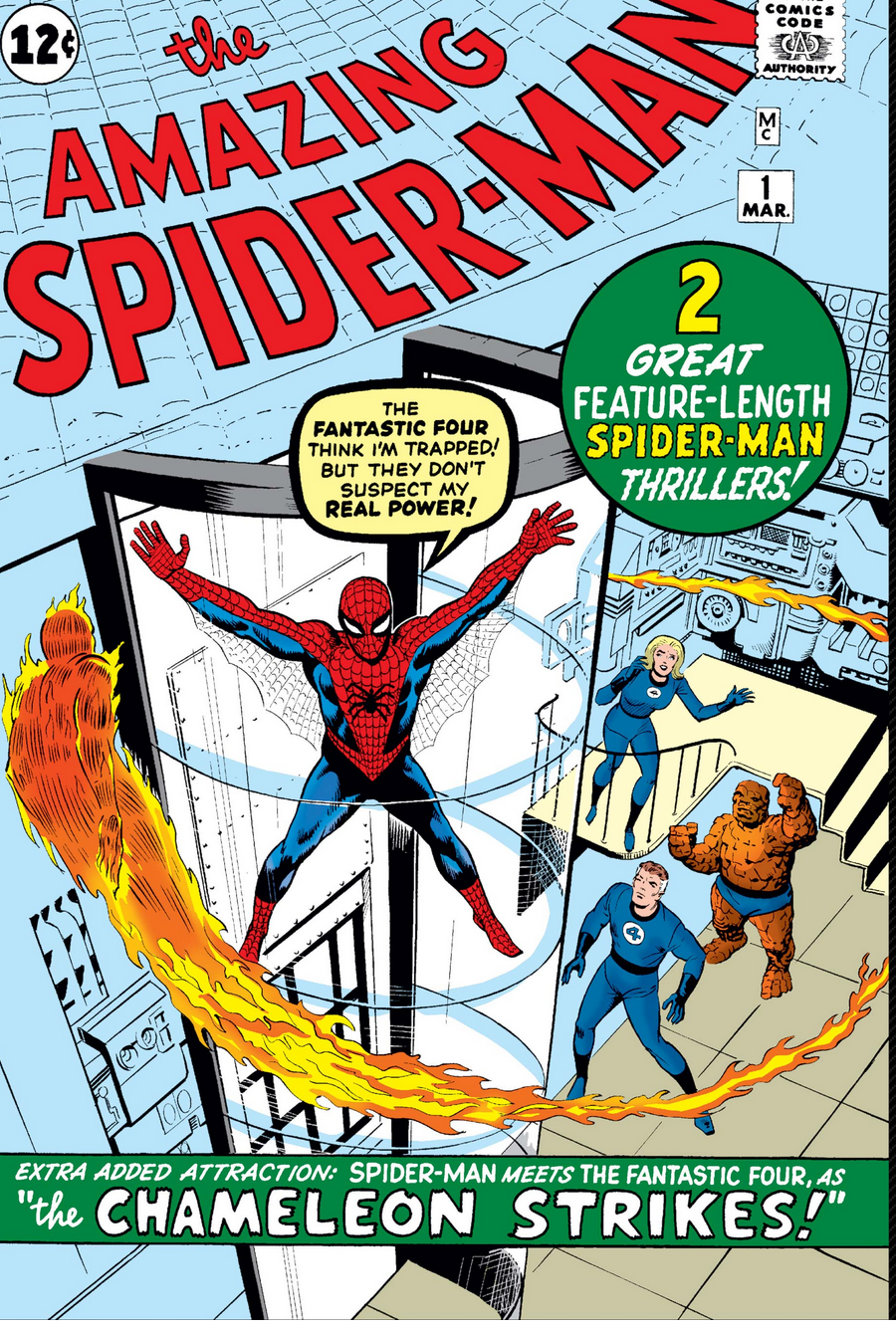Creative Team:
Writer: Stan Lee Penciller: Steve Ditko, Sol Brodsky
Maybe Steve Ditko could foretell how iconic this first issue of The Amazing Spider-Man was to become, and it begins with the lavish detail shown to the cover art featuring the Fantastic Four and Spider-Man, who were to be Marvel’s first breakout successes in the marketplace for superhero “teams” and individual superhero-focused comics, respectively. The first run of Fantastic Four started in 1961, kicking off the Marvel Era in the continuity. Released monthly alongside the contemporary bestsellers (noticeably including many more genres in Marvel’s lineup other than superheroes), Fantastic Four’s first series run was a crucial way for Marvel to effectively test the popularity of new characters introduced during the Sixties and was an early attempt to compete with the Justice League of America from rival publisher DC Comics. While today, the Fantastic Four is less well-known in popular culture, having failed to appeal to modern fans of the Marvel Cinematic Universe, which is a crucial source of in-universe concepts for many new readers walking into their local comic book shops for the first time or browsing trade paperbacks in mass market bookstores. Even though moviegoers will associate Spider-Man with the Avengers, it is cool that Spider-Man’s first co-stars were the Fantastic Four!

Now, back to the cover art. The Human Torch and Spider-Man are shown in the greatest detail of the featured characters, yet the visual framing of the depiction allows all five characters and a detailed science fiction-inspired laboratory to characterize some of the previewed themes of Stan Lee and Steve Ditko’s opening run on The Amazing Spider-Man: A hero doubted by others, dramatic action and suspense, the thrill of the promises of science and technology. There is good reason for this issue to be one of the most valuable pop culture collectibles in the world.
The first story quickly establishes Peter’s infamous canon tragedy to have occurred in the recent past, featuring panels of expository details through overt exposition and Peter’s self-talk and internal monologues occurring in several frames. Quickly, we come to see Peter as a tad self-obsessed and perhaps lacking the moral fiber he would later be known for. While Peter does take revenge against the perpetrator of his tragedy, he hands the criminal over to the police. However, his qualms against stealing focus not on the moral or ethical wrongs of thievery but instead on the consequences of being caught or labeled a criminal. While Peter is focused on making money using his costume and abilities, an adversary appears to pit the public against the new masked hero. J. Jonah Jameson is depicted as having a potential personal interest in a crusade against Spider-Man, namely, establishing the legacy of his astronaut son and selling papers.
The science fiction theme of The Amazing Spider-Man is established in the second part of the story. The fantastical seems within reach, easily explained by the laws of physics, chemistry, biology, and the almost magical concept of nuclear energy. During the Sixties, the United States was intensely preoccupied with the Space Race and technological advancements to stay ahead of this issue’s enemies: Soviet communists, agents of espionage whose historical context extends to real spies, but also innocent people accused in the anti-Communist hysteria. I’d imagine that both American propaganda and contemporary life provided a multitude of Communist caricatures for Lee and Ditko’s stories throughout the Cold War, but especially while the Communist world seemed to be growing and nuclear annihilation seemed inevitable, leading to the culturally repressive period known as the Red Scare in the Fifties.

I hesitate to provide a numeric rating at this time due to a lack of developed criteria, instead preferring to rate “Keep, Read, Pass”. A “Keep” Rating indicates an issue or volume having some merit beyond just a few minutes spent reading a story once or twice, for a variety of factors. A “Read” Rating indicates an issue or volume worth paying to read. A “Pass” Rating indicates an issue or volume not worth the time, trouble, or funds to collect and can be read at leisure electronically unless it fits your collection. At this time, I have yet to form a solid opinion on the art style of Ditko, but I cannot help to notice that the advancements of the arts through computerized design make modern comics seem much more detailed and lively than these early iterations. Ditko’s still drawings retain the magic of innovation, demanding respect as the genesis of the character we have all come to love.
Rating: KEEP

